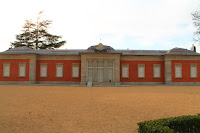This one's for you, Mom. About a month ago, I was researching some day trips to take from Madrid on the weekends and came across a town with windmills like the ones that inspired
El Quijote. I went to the bus station here to ask about the bus schedules and prices the week prior. Then, when I got to the bus station to purchase tickets the Saturday that Nicole and I decided to go, I discovered that no, the 11 am bus actually does not stop in Consuegra on Saturdays and the next one that does leaves at 1:15 pm. Considering the trip is over two hours, we decided that wouldn't be worth it. So in a scramble to save our Saturday, we decided to go to Alcala de Henares, one of the more popular (not to mention shorter) day trips from Madrid that (shamefully) neither of us had been to.
 |
| Facade of the university |
 |
| White storks |
Alcala is famous for two or three main things: it's university, whose buildings date back to the very end of the 15th century, the birthplace and childhood home of Cervantes, and, less so, the insanely large population of white storks. The original university, the Universidad Complutense, was moved during the 19th century to Madrid and retains the same name today. The Universidad de Alcala now uses the original buildings (plus new ones; the campus is split in a few locations throughout the city), and you can take a guided tour of them if you visit the city. Every year, the king and queen of Spain present the Premio Cervantes (Cervantes Prize) in the Great Hall of the old university to an important figure in the Spanish-speaking literature world. The prize is a pretty big deal because it commemorates the life work of the writer, rather than just one particular piece of literature, and in addition to the king and queen, many other important people are present for the ceremony.
 |
| Don Quijote & Sancho Panza in front of the Cervantes' house. |
I have to say that I was a bit disappointed by the Cervantes birthplace. The house is overall interesting enough; the rooms and the furniture are representative of a typical house of the Golden Age of Spain (16th century), and there is a room with various editions (old, new, in foreign languages) of
El Quijote. However, there was very little information in the house about...well, anything (his life, the house, rooms, furniture, etc.).
Another place we visited in Alcala was the Corral de Comedias, which is a type of theater typical of the Golden Age of Spain. The one in Alcala is one of the oldest of this type of theater still in existence in Europe. Although it is now enclosed completely, the
corral de comedias was an outdoor theater in an interior patio of a block of buildings. The Corral de Comedias in Alcala is located on the main square of the city, the Plaza de Cervantes (in the middle of which is a huge statue of Cervantes).
All in all, Alcala is a nice little city that's worth a visit, especially if you're a Cervantes or
Quijote fan. Here are the rest of the photos that I took for those interested.







